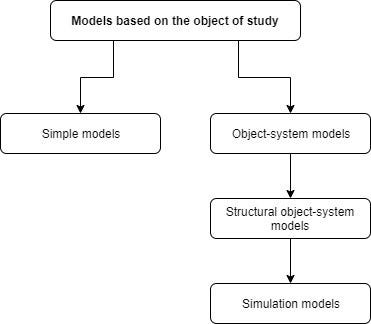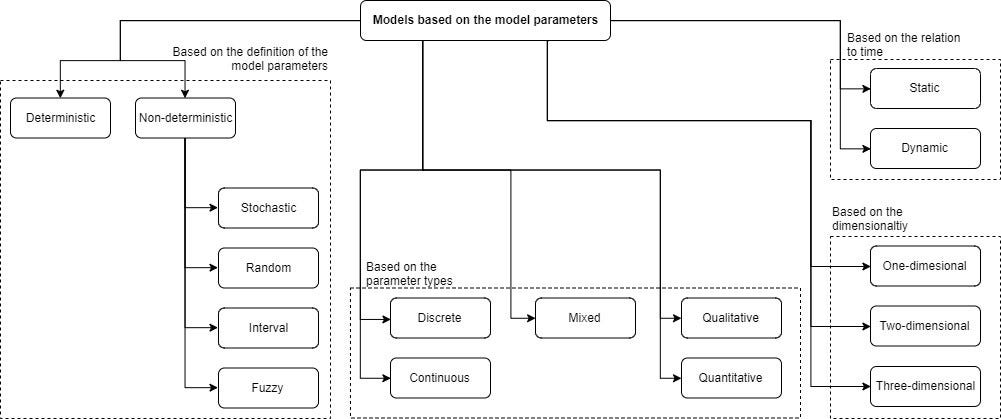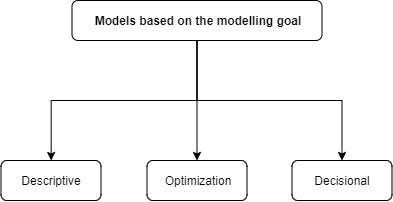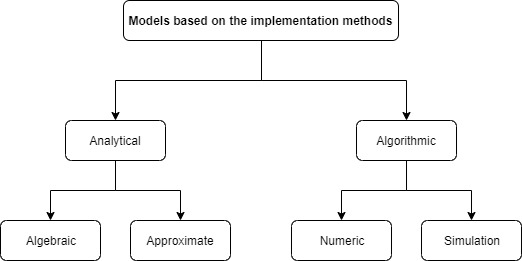In Mathematical Terms A Link Is Called A An Answer
Classification of mathematical models
Introduction
This article provides a brief overview of what the mathematical modeling and the mathematical models are and how the mathematical models are classified depending on various features they can be characterized with. The article is in no way a comprehensive guide of the topic since there are a big number of ways mathematical models can be classified in, but rather an introductory explanation of the extremely broad area of mathematical modelling. The material of the article is heavily influenced by the book [1].
Modelling basics
The model is a physical or thought object aimed to replace the original object during the study process, while preserving certain features significant for the current research. The processes of designing and utilization of the model are called the modeling. In plain words, a model is something built by a researcher to represent his object of study when it is unavailable due to the expensiveness, transportation difficulties or other reasons.
Examples of the models can be a miniature copy of a building built prior to the launch of the construction, drawings of a new industrial equipment, computer simulation of a liquid flow in a pipe. Even the lab experiments of a new medicine on mice and rats can be thought of as a modeling being made because of the unethical nature of conducting the similar experiments on humans.
Modeling in itself is a complex term as it allows to be approached and performed in lots of ways. One of the sub-part of modeling is mathematical modeling.
Mathematical modeling is an idealized scientific modeling, in which an object of study is described with the means of mathematics and research is done with the mathematical methods. Such description of the object in mathematical terms is then called the mathematical model.
In formal terms, a mathematical model is a mathematical operator A that maps the set of inputs X of the model from the set of its allowed values (Ωx) to the set of outputs Y of the model from the set of its allowed values (Ωy).

Mathematical models can be classified in many ways depending on:
● the complexity of the object of study;
● model operator;
● model parameters;
● modelling goal;
● model implementation methods.
We'll look closer at each of these classifications below.
Model types based on the object of study
As like the models themselves, the object of study can represent a wide range of real-life objects, but generally the range of the objects can be divided into two major categories: simple objects and object-systems. A simple object is an object which internal structure is neglectable for the current research, so there's no need to dive into the details of how the object is made or which sub-processes it has. An example of such simple object is a weightless material point in classic mechanics.
On the contrary, an object-system is a set of connected elements divided by some boundary from the exterior and interacting with the exterior as a whole. An example of the object-system can be the model of an airplane that is comprised of a number of elements and sub-systems and has to interact with the environment during its operation.
One sub-type of the object-system is the structural object-systems. These are the object-systems where the properties, behaviors and interconnections between the elementary parts of the object-system are taken into account. This is a more complex type of mathematical modelling, subject to the field of systems analysis.
Going further, one more sub-type of the structural object-systems is the simulation systems which consist of a limited number of elementary parts each having a finite set of states it can be in. This type of models is widely used in engineering and science, for example, when design the digital twins of industrial equipment under plant operation.
The figure below show the classification of mathematical models based on the object of study.

Model types based on the model operator
Another way to classify mathematical models is based on the operator the model represents. The operator can vary depending on the object the model is used for.
A model is said to be linear if its operator uses linear dependencies between the model's outputs and inputs. Such model are probably the easiest for analysis. This also concludes another important feature of linear models: superposition. That is, if the model's response for two sets of inputs X1 and X2 is known and equals Y1 and Y2, the model response for the sum of inputs X1+X2 will be exactly the sum of outputs Y1+Y2.
Non-linear models are the models where the operator uses non-linear dependencies between outputs and inputs. They are more difficult for analysis and don't have the superposition property when compared to linear models.
Based on the operator, the models can also be classified as simple and complex. If the model's operator is a concise dependency of outputs from inputs (like a direct formula), the model is said to be simple. If the model's operator requires additional operations to ascertain the dependencies between outputs and inputs, as if it is defined as a set of differential equations, the model is said to be complex.
A thing to note here is that if such set of equations can be solved analytically, either precisely or approximately with a decent level of accuracy, complex models can be turned to simple.
If the model's operator is expressed in algorithmic form, as a sequence of steps to relate inputs to outputs, the model is said to be algorithmic.
The figure below show the classification of mathematical models based on the model operator. Please note that the branches of the classification are not mutually exclusive, as a single model can be, for example, both non-linear, algorithmic and complex.

Model types based on the model parameters
Each mathematical model can use up to four distinct and non-overlapping sets of parameters:
● input parameters which are used as inputs for the model's operator;
● output parameters which are returned by the model's operator from the set of the model inputs;
● influencing and uncontrollable parameters which cannot be directly influenced by the model designer and which can directly affect the model's output parameters;
● influencing and controllable parameters which the model designer can directly control and adjust during the model's operation and which can directly affect the model's output parameters.
Examples of uncontrollable parameters can be wind speed and direction in the airplane model. Apparently these parameters need to be taken into account during the simulation but the model cannot influence them directly. Controllable parameters can be the model's internal parameters, for example the size of the rolling average window in the model which uses data smoothing.
Models can be classified depending on the nature of these four groups of parameters.
The figure below show the classification of mathematical models based on the model parameters. Each type of model is explained further below. Again, note that the branches of the classification are not mutually exclusive, as a single model can be, for example, both stochastic, discrete, two-dimensional and dynamic.

Based on the definition of the model parameters
Deterministic models are the models where each parameter is defined in an unambiguous ways, that is each parameter value can be represented as a concrete number.
Conversely, non-deterministic models are the models which parameters cannot be expressed in deterministic way. Such models can be divided into stochastic, random, interval and fuzzy.
Stochastic models are the models where each parameter is defined in some probabilistic way, expressed in the form of probability dustribution functions, thus bringing a level of randomness in the model's outputs.
Random models are the models where all model parameters are set by random values, defined with probability distributions from the observed experimental results. This kind of model is connected to the previous, stochastic type, but the parameters in random models are initially viewed as random values that need to be described with probability distributions, while in stochastic models the probabilistic component can emerge due to the uncertainty of the instruments used to measure the model's parameters.
Interval models are the models where all model parameters are defind by interval values, as if each parameters can take values from a pre-defined range.
Fuzzy models are the models where the parameters are defined by their membership functions of a fuzzy set, for example, an expert's verbal assessment of the variable as 'decent' or 'most likely more than 10'.
Based on the parameter types
Depending one the types of the parameters used in the model, the models can be discrete, continuous, quantitative, qualitative or mixed.
Discrete models are the models where the model parameters are treated as discrete values, as opposed to continuous models where the parameter values can change in a continuous manner. For example, the airplane model where the power of the main engine can only be chosen from a pre-defined set of engines available on the market, can be thought of as a discrete in this regard. While at the same time, if the main engine is scheduled to be manufactured from the airplane's designers demand specifications, the engine power can be used as a continuous value, so the airplane model can be treated as continuous in this case.
Qualitative values are the models where the parameters are defined as the variables that are not measurable. Their values do not result from measuring or counting. Such parameters can be expressed as colors (red, blue, green), proper names (John, Mary, Steve) or other categories. Quantitative are expressed as countable numbers. The core difference between these types of parameters is that any two quantitative parameters can be directly compared (as 5 meters is more than 2 meters) while quantitative parameters cannot (as it's impossible to say what is bigger judging from only color: red part or blue part).
When the model use parameters of different types, the model is said to be mixed.
Based on the dimensionality
The models operating with special coordinates can be divided based on the dimensionality of the space they operate in. Such models can be:
● one-dimensional, as if modelling the motion of a particle on a straight line;
● two-dimensional, as if modelling ships' routes on a surface of a sea;
● three-dimensional, as if modelling a flying drone's motion in an urban environment.
Often the complexity of a model is heavily dependent on the model's dimensionality due to the increase in the number of mathematical equations describing the model's behavior.
Based on the relation to time
The models can either use time as one of its parameters, or not use it. When the model describes some static object which state is not changed over time, the model is said to be static. There's no need to use the time as a parameter in such models.
When the model describes some dynamic object which state is changed over time, the model is said to be dynamic and the time is a mandatory parameter to be used in the model.
Model types based on the modelling goal
Depending on the modelling goal, the models are classified as descriptive, optimization and decisional.
Descriptive models are used to describe the changes to the object of study. For example, a model of a space rocket launched from one point on the Earth is descriptive as its goal is to define the rocket's speed and coordinates in any single moment of time after the launch.
Optimization models are used to find the most optimal parameters of the object of study given the optimization criteria. Example of such model can be the model aimed to find the smallest possible mass of a rocket launched from the Earth to achieve a certain point in the space.
Decisional models are used to predict the most efficient solutions in various areas of human activities. Often such models provide the expected outcomes for the available range of decisions in the studied area, thus making the foundation for the choice of the decision with the most favorable effect for the entire process. As an example, a tech company's CTO choice for a vacant position of a team lead from the range of candidates. The candidates may have various skillsets and each his own pros and cons, so the right choice at the first glance may not be obvious. This is different to optimization models where the optimization criteria are concise, since the right choice in the decisional models is made with a level of uncertainty and can be subjected to whoever is building the model: some CTOs may value communication skills first, while others can view tech skills as more important.
The figure below show the classification of mathematical models based on the model parameters.

Model types based on the model implementation methods
Based on the implementation details, mathematical models can be divided into two categories: analytical and algorithmic.
Analytical models are the models that allow its output parameters to be expressed analytically, as a combination of mathematic operations over its inputs, controllable and uncontrollable parameters. Examples of such models can be the model of the trajectory of a ball thrown up with the known velocity and under the known angle to the horizon. If the ball's size and the wind speed are small and can be not taken into account, the trajectory can be expressed anaytically as a straight formula.
Furthermore, analytical models are divided into algebraic and approximate models. Algebraic models are the models when the finite number of algebraic operations can be used to relate the model outputs with the other model's parameters. Approximate models are the models that cannot define the model outputs in a finite number of operations, for example, because of the complexity of the model. Instead, approximations are used in this kind of models. For example, in some models the value of e to the power of x can be approximated as:

Depending on how many members of this row are taken for the calculation, the result will be more or less the good approximate. Such approaches are used in approximate models.
Algorithmic models are the models where the outputs of the model are calculated approximately, following the algorithmic approach. Algorithmic models are divided into numeric and simulation models.
In numeric models the mathematical description of the object of study (for example, a set of equations) is replaced with its simplified copy. This is achieved, for example, with the transition from continuous mathematical equations to discrete ones and then developing the computational algorithm to solve the final set of equations.
In simulation models the object of study itself is replaced with its simplified discrete copy. For example, a liquid flow inside a volume can be modelled by the means of computational flow dynamics, where the entire volume of liquid is split into a mesh of elementary volumes, and then a set of equations is defined for each of the volumes.
The figure below show the classification of mathematical models based on the implementation methods.

List of sources
1. V.N. Ashikhmin et al. „Introduction to the mathematical modelling" (in Russian): https://www.researchgate.net/publication/296331008_Vvedenie_v_matematiceskoe_modelirovanie
2. Qualitative versus quantitative: https://www2.southeastern.edu/Academics/Faculty/dgurney/Math241/StatTopics/QualVsQuant.htm
In Mathematical Terms A Link Is Called A An Answer
Source: https://medium.com/engineering-approach/classification-of-mathematical-models-270a05fcac4f
Posted by: langleyyoushothe.blogspot.com

0 Response to "In Mathematical Terms A Link Is Called A An Answer"
Post a Comment